Cross-Cultural Management Report: Theories, Models, and Global Teams
VerifiedAdded on 2023/01/12
|17
|5188
|41
Report
AI Summary
This report provides a comprehensive overview of cross-cultural management, emphasizing its significance in international business environments. It explores the concept of cross-culture, defining it as the ability to understand and leverage cultural differences for high performance, focusing on the interaction between local and global employees. The report uses Marks and Spencer as a case study to illustrate the practical application of cross-cultural management. It delves into the importance of cross-culture, highlighting how organizations operating internationally require cross-cultural management to navigate diverse behaviors and backgrounds. The report then examines several key models and theories, including Hofstede's cultural dimensions (power distance, individualism, uncertainty avoidance, masculinity, long-term orientation, and indulgence), Trompenaars' seven dimensions (universalism vs. particularism, individualism vs. collectivism, neutral vs. emotional, specific vs. diffuse, achieved vs. ascribed status), and Hall's theory. The report concludes by discussing the implications of these theories on the successful management of global teams, offering insights into effective cross-cultural management strategies.
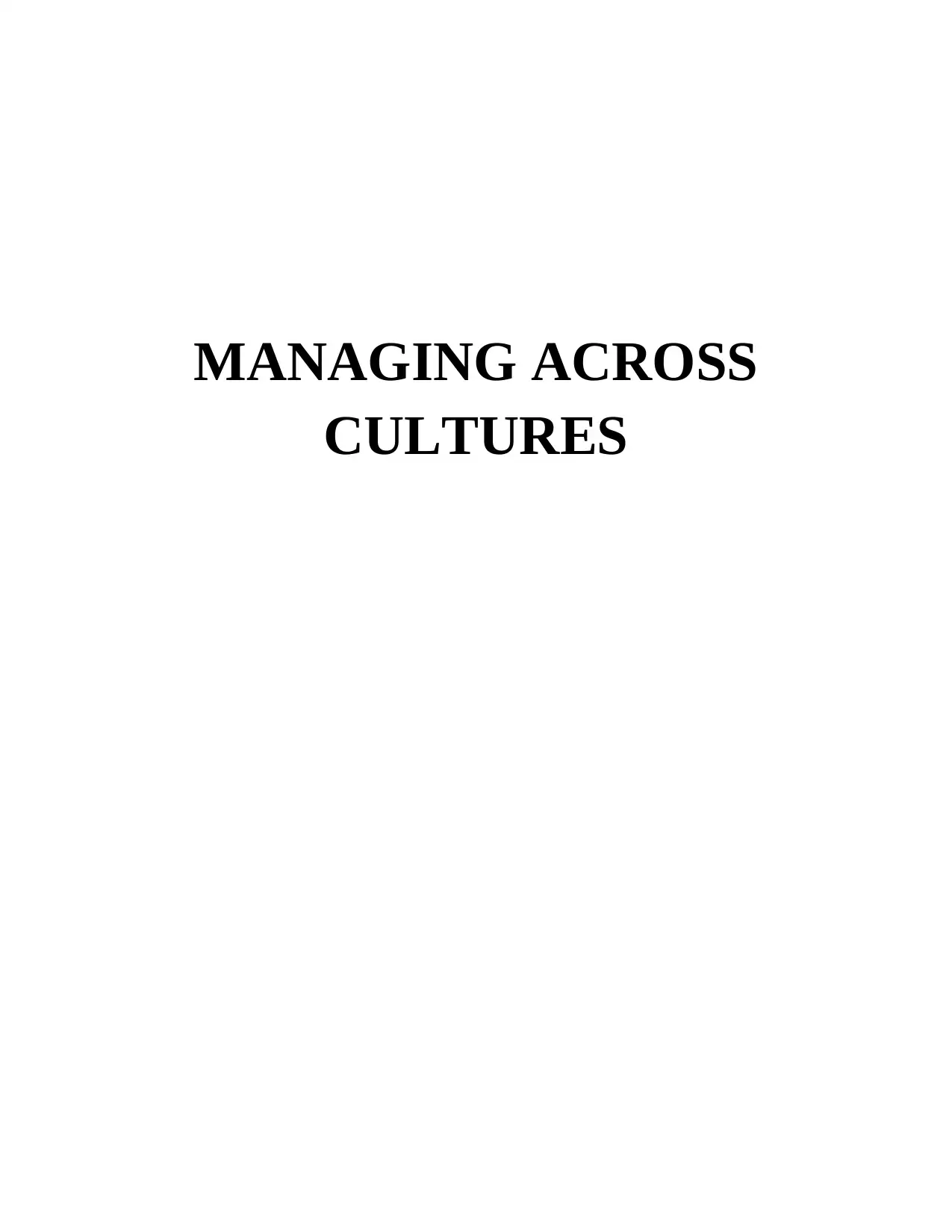
MANAGING ACROSS
CULTURES
CULTURES
Paraphrase This Document
Need a fresh take? Get an instant paraphrase of this document with our AI Paraphraser
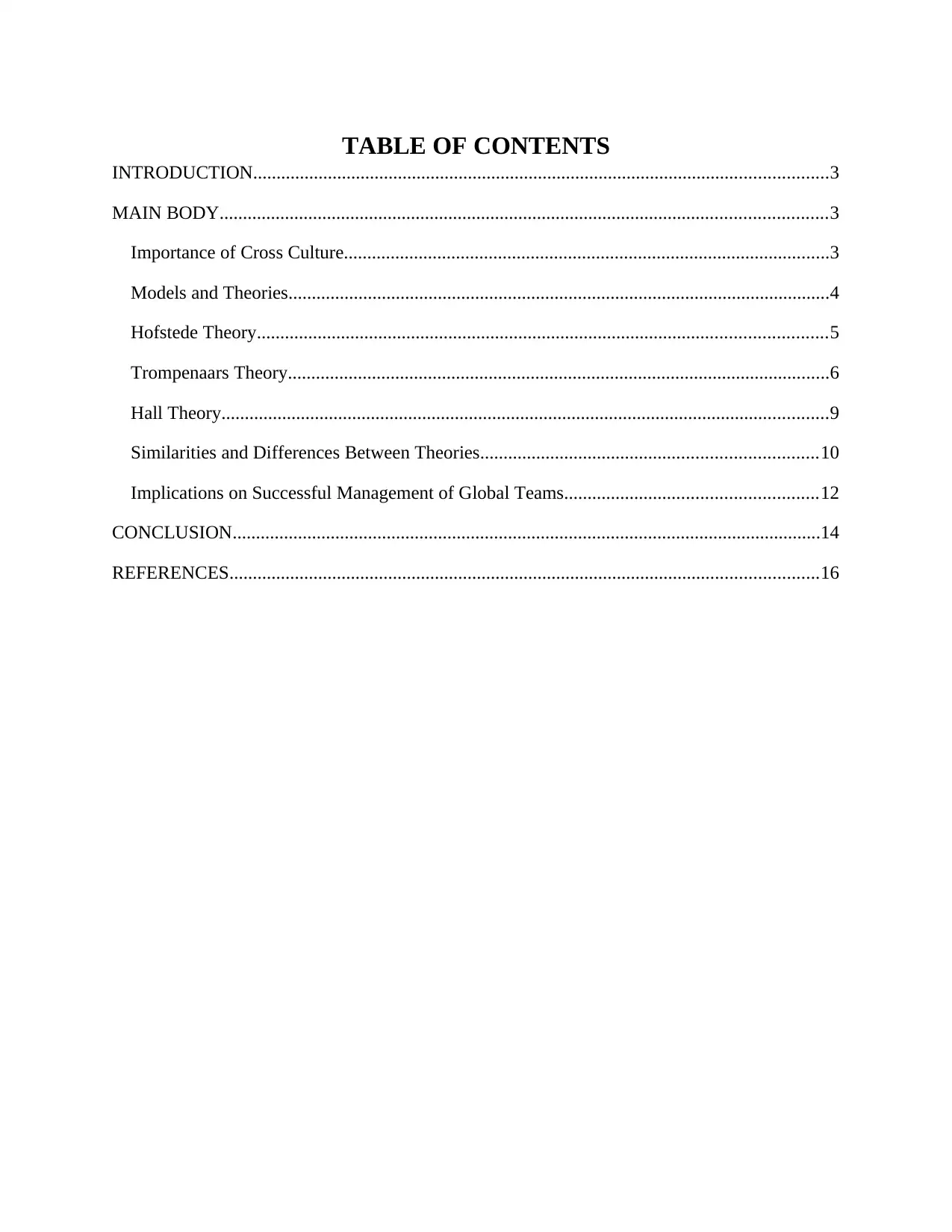
TABLE OF CONTENTS
INTRODUCTION...........................................................................................................................3
MAIN BODY..................................................................................................................................3
Importance of Cross Culture........................................................................................................3
Models and Theories....................................................................................................................4
Hofstede Theory..........................................................................................................................5
Trompenaars Theory....................................................................................................................6
Hall Theory..................................................................................................................................9
Similarities and Differences Between Theories........................................................................10
Implications on Successful Management of Global Teams......................................................12
CONCLUSION..............................................................................................................................14
REFERENCES..............................................................................................................................16
INTRODUCTION...........................................................................................................................3
MAIN BODY..................................................................................................................................3
Importance of Cross Culture........................................................................................................3
Models and Theories....................................................................................................................4
Hofstede Theory..........................................................................................................................5
Trompenaars Theory....................................................................................................................6
Hall Theory..................................................................................................................................9
Similarities and Differences Between Theories........................................................................10
Implications on Successful Management of Global Teams......................................................12
CONCLUSION..............................................................................................................................14
REFERENCES..............................................................................................................................16

INTRODUCTION
Culture refers as a set of principles and morals about what is expected and unexpected
and sets of formal and informal practice for helping the morals. In other word, it is specific set of
customer, values, beliefs and tradition from a particular time and place. While managing across
culture can be defined as the ability to maintain and power of culture differences which plays
important role for achieving high performance. It is a two away procedure which involves local
and global employees and employers of different businesses. The main objective to manage
across cultures is to understand different cultural employees and appreciates them by using
different cultural factors. To manage across culture is a big deal for organization but it leads high
profitability within workplace. it is not only supported company to upgrade its brand image but
also lead innovation within company. There is an example of Marks and Spencer company
which mange cross culture in global level. It is a British multinational company who offers their
services worldwide.
The brief study of the report helps to understand cross culture management. It will
discuss and evaluates and the significance of national culture in the international management.
The report encompasses implication of cross culture which supports managers for successfully
managing global virtual team in the global environment.
MAIN BODY
Importance of Cross Culture
Cross culture is too important in international management. An organisation which operates their
business operations in the international market is highly required cross culture management in its
business environment. Reason is, people not has same behaviour and background in all places
(Cameron, K., 2017). Each person is something different from other one, by culture wise, by
caste wise and by religion wise. In this situation, cross culture helps to organisation for dealing
with people who comes from different background. For example; Currently Marks and Spencer
(M&S) offers their products and services in many countries, so top-level management has
prepared a plan for dealing with different geographical conditions. Currently many people or
employees are working in daily operations of M&S, in which these employees not come from
Culture refers as a set of principles and morals about what is expected and unexpected
and sets of formal and informal practice for helping the morals. In other word, it is specific set of
customer, values, beliefs and tradition from a particular time and place. While managing across
culture can be defined as the ability to maintain and power of culture differences which plays
important role for achieving high performance. It is a two away procedure which involves local
and global employees and employers of different businesses. The main objective to manage
across cultures is to understand different cultural employees and appreciates them by using
different cultural factors. To manage across culture is a big deal for organization but it leads high
profitability within workplace. it is not only supported company to upgrade its brand image but
also lead innovation within company. There is an example of Marks and Spencer company
which mange cross culture in global level. It is a British multinational company who offers their
services worldwide.
The brief study of the report helps to understand cross culture management. It will
discuss and evaluates and the significance of national culture in the international management.
The report encompasses implication of cross culture which supports managers for successfully
managing global virtual team in the global environment.
MAIN BODY
Importance of Cross Culture
Cross culture is too important in international management. An organisation which operates their
business operations in the international market is highly required cross culture management in its
business environment. Reason is, people not has same behaviour and background in all places
(Cameron, K., 2017). Each person is something different from other one, by culture wise, by
caste wise and by religion wise. In this situation, cross culture helps to organisation for dealing
with people who comes from different background. For example; Currently Marks and Spencer
(M&S) offers their products and services in many countries, so top-level management has
prepared a plan for dealing with different geographical conditions. Currently many people or
employees are working in daily operations of M&S, in which these employees not come from
⊘ This is a preview!⊘
Do you want full access?
Subscribe today to unlock all pages.

Trusted by 1+ million students worldwide
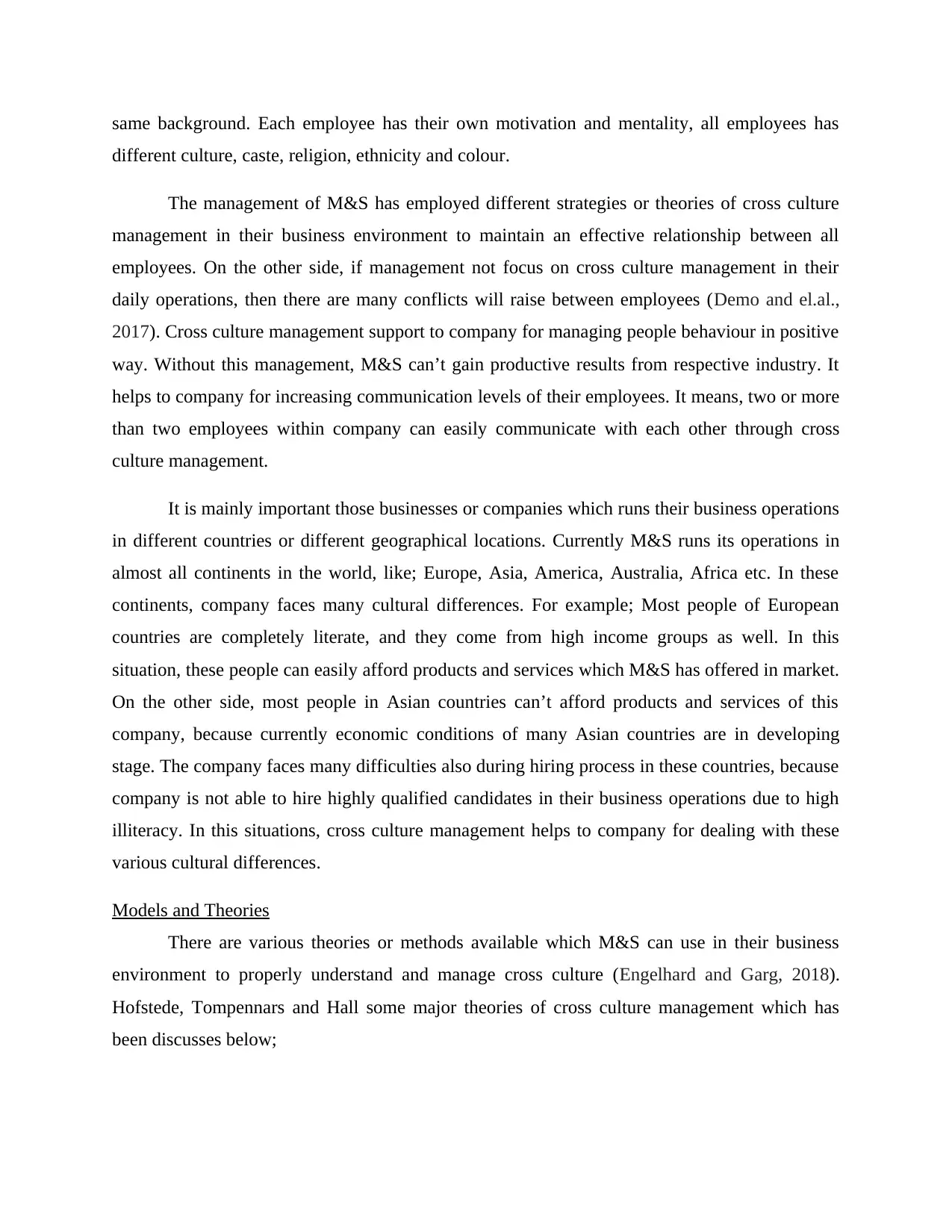
same background. Each employee has their own motivation and mentality, all employees has
different culture, caste, religion, ethnicity and colour.
The management of M&S has employed different strategies or theories of cross culture
management in their business environment to maintain an effective relationship between all
employees. On the other side, if management not focus on cross culture management in their
daily operations, then there are many conflicts will raise between employees (Demo and el.al.,
2017). Cross culture management support to company for managing people behaviour in positive
way. Without this management, M&S can’t gain productive results from respective industry. It
helps to company for increasing communication levels of their employees. It means, two or more
than two employees within company can easily communicate with each other through cross
culture management.
It is mainly important those businesses or companies which runs their business operations
in different countries or different geographical locations. Currently M&S runs its operations in
almost all continents in the world, like; Europe, Asia, America, Australia, Africa etc. In these
continents, company faces many cultural differences. For example; Most people of European
countries are completely literate, and they come from high income groups as well. In this
situation, these people can easily afford products and services which M&S has offered in market.
On the other side, most people in Asian countries can’t afford products and services of this
company, because currently economic conditions of many Asian countries are in developing
stage. The company faces many difficulties also during hiring process in these countries, because
company is not able to hire highly qualified candidates in their business operations due to high
illiteracy. In this situations, cross culture management helps to company for dealing with these
various cultural differences.
Models and Theories
There are various theories or methods available which M&S can use in their business
environment to properly understand and manage cross culture (Engelhard and Garg, 2018).
Hofstede, Tompennars and Hall some major theories of cross culture management which has
been discusses below;
different culture, caste, religion, ethnicity and colour.
The management of M&S has employed different strategies or theories of cross culture
management in their business environment to maintain an effective relationship between all
employees. On the other side, if management not focus on cross culture management in their
daily operations, then there are many conflicts will raise between employees (Demo and el.al.,
2017). Cross culture management support to company for managing people behaviour in positive
way. Without this management, M&S can’t gain productive results from respective industry. It
helps to company for increasing communication levels of their employees. It means, two or more
than two employees within company can easily communicate with each other through cross
culture management.
It is mainly important those businesses or companies which runs their business operations
in different countries or different geographical locations. Currently M&S runs its operations in
almost all continents in the world, like; Europe, Asia, America, Australia, Africa etc. In these
continents, company faces many cultural differences. For example; Most people of European
countries are completely literate, and they come from high income groups as well. In this
situation, these people can easily afford products and services which M&S has offered in market.
On the other side, most people in Asian countries can’t afford products and services of this
company, because currently economic conditions of many Asian countries are in developing
stage. The company faces many difficulties also during hiring process in these countries, because
company is not able to hire highly qualified candidates in their business operations due to high
illiteracy. In this situations, cross culture management helps to company for dealing with these
various cultural differences.
Models and Theories
There are various theories or methods available which M&S can use in their business
environment to properly understand and manage cross culture (Engelhard and Garg, 2018).
Hofstede, Tompennars and Hall some major theories of cross culture management which has
been discusses below;
Paraphrase This Document
Need a fresh take? Get an instant paraphrase of this document with our AI Paraphraser

Hofstede Theory
Hofstede is the most popular theory for understanding cross-culture communication and
management. This theory was introduced by Geert Hofstede, where it has discussed various
culture of society. Geert said that people always behave according to their cultural values and
background. This theory provides a specific framework to companies or businesses for properly
managing cross culture in their daily operations. Hofstede cultural theory mainly includes six
major categories of cultures which has been discussed below;
Power Distance Index: According to power distance index, cultures always change after a
certain geographical distance. Not all places have same cultural values, people are completely
different with each other in every place. In this situation, M&S need to present their products and
services according to a geographical need. Due to different cultures, people has different demand
as well. Currently company need to provide different products and services in different
continents. For example; in many places people give priority to quality of product, and in some
places people give priority to quantity of product (Deschacht and Maes, 2017). That’s why
companies or businesses including M&S need to fulfil demand of customers according to their
cultural differences.
Collectivism vs. Individualism: People behaviours always changes according to their workplace.
For example; when a person works in a teamwork, on that time person take care of its whole
team, other team members and other employees. On the other side, when that same person works
individually, on that time person only take care of themselves, and their family members etc.
There is collectivism indicates a team work or a group work where many people come together
for achieving common goals. There is individualism indicates situation where an individual
person takes various steps towards achieving their targets.
Uncertainty vs. Avoidance Index: Uncertainty and avoidance are also two different aspects of
culture. Top-level management within M&S always takes various steps towards dealing with
uncertainty. This aspect of culture always negatively influences daily operations of company. On
the other side, avoidance is another major aspect where company should prepare a specific plan
to manage avoidance index. According to this aspect, top-level management of company always
ned to avoid such activities in their business environment which can harm its progress.
Hofstede is the most popular theory for understanding cross-culture communication and
management. This theory was introduced by Geert Hofstede, where it has discussed various
culture of society. Geert said that people always behave according to their cultural values and
background. This theory provides a specific framework to companies or businesses for properly
managing cross culture in their daily operations. Hofstede cultural theory mainly includes six
major categories of cultures which has been discussed below;
Power Distance Index: According to power distance index, cultures always change after a
certain geographical distance. Not all places have same cultural values, people are completely
different with each other in every place. In this situation, M&S need to present their products and
services according to a geographical need. Due to different cultures, people has different demand
as well. Currently company need to provide different products and services in different
continents. For example; in many places people give priority to quality of product, and in some
places people give priority to quantity of product (Deschacht and Maes, 2017). That’s why
companies or businesses including M&S need to fulfil demand of customers according to their
cultural differences.
Collectivism vs. Individualism: People behaviours always changes according to their workplace.
For example; when a person works in a teamwork, on that time person take care of its whole
team, other team members and other employees. On the other side, when that same person works
individually, on that time person only take care of themselves, and their family members etc.
There is collectivism indicates a team work or a group work where many people come together
for achieving common goals. There is individualism indicates situation where an individual
person takes various steps towards achieving their targets.
Uncertainty vs. Avoidance Index: Uncertainty and avoidance are also two different aspects of
culture. Top-level management within M&S always takes various steps towards dealing with
uncertainty. This aspect of culture always negatively influences daily operations of company. On
the other side, avoidance is another major aspect where company should prepare a specific plan
to manage avoidance index. According to this aspect, top-level management of company always
ned to avoid such activities in their business environment which can harm its progress.
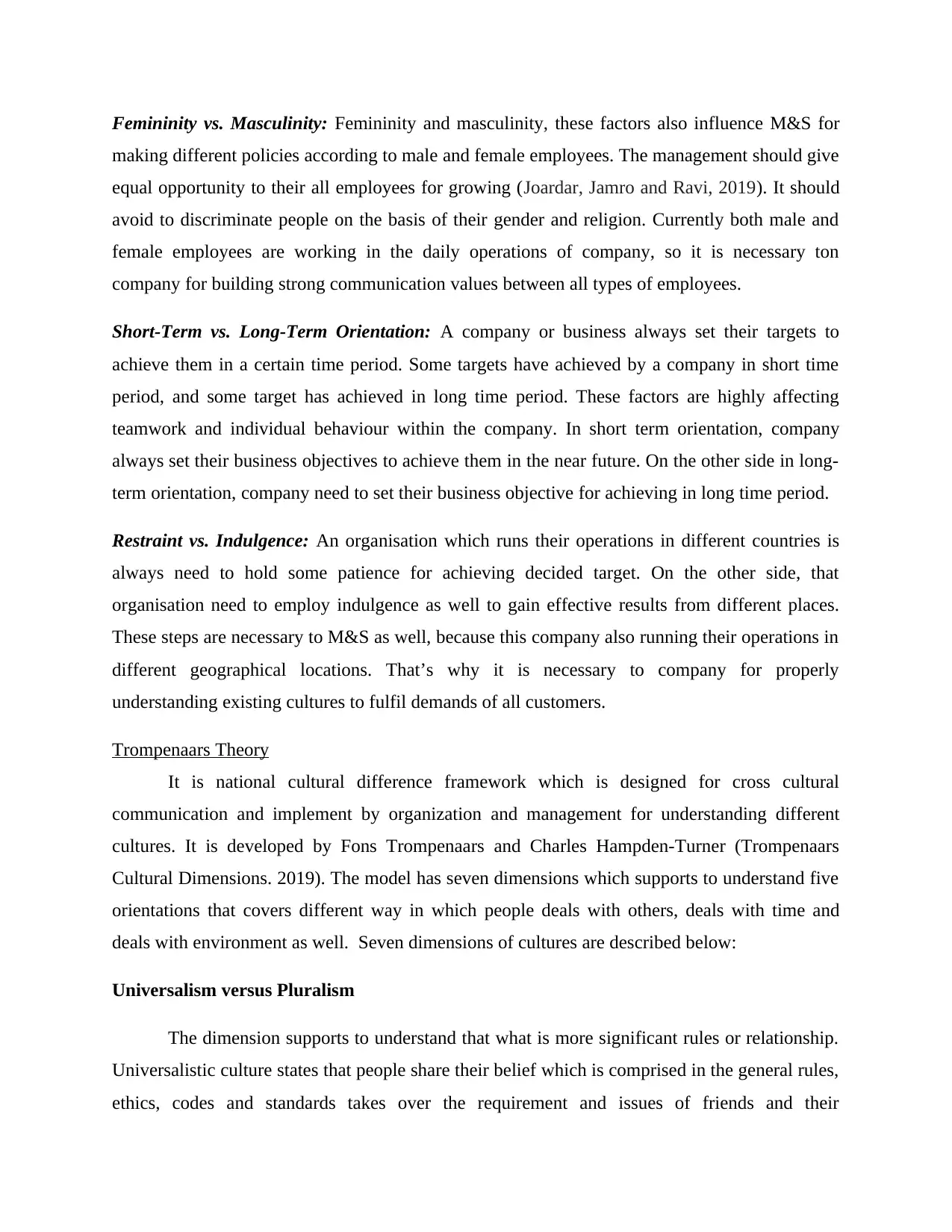
Femininity vs. Masculinity: Femininity and masculinity, these factors also influence M&S for
making different policies according to male and female employees. The management should give
equal opportunity to their all employees for growing (Joardar, Jamro and Ravi, 2019). It should
avoid to discriminate people on the basis of their gender and religion. Currently both male and
female employees are working in the daily operations of company, so it is necessary ton
company for building strong communication values between all types of employees.
Short-Term vs. Long-Term Orientation: A company or business always set their targets to
achieve them in a certain time period. Some targets have achieved by a company in short time
period, and some target has achieved in long time period. These factors are highly affecting
teamwork and individual behaviour within the company. In short term orientation, company
always set their business objectives to achieve them in the near future. On the other side in long-
term orientation, company need to set their business objective for achieving in long time period.
Restraint vs. Indulgence: An organisation which runs their operations in different countries is
always need to hold some patience for achieving decided target. On the other side, that
organisation need to employ indulgence as well to gain effective results from different places.
These steps are necessary to M&S as well, because this company also running their operations in
different geographical locations. That’s why it is necessary to company for properly
understanding existing cultures to fulfil demands of all customers.
Trompenaars Theory
It is national cultural difference framework which is designed for cross cultural
communication and implement by organization and management for understanding different
cultures. It is developed by Fons Trompenaars and Charles Hampden-Turner (Trompenaars
Cultural Dimensions. 2019). The model has seven dimensions which supports to understand five
orientations that covers different way in which people deals with others, deals with time and
deals with environment as well. Seven dimensions of cultures are described below:
Universalism versus Pluralism
The dimension supports to understand that what is more significant rules or relationship.
Universalistic culture states that people share their belief which is comprised in the general rules,
ethics, codes and standards takes over the requirement and issues of friends and their
making different policies according to male and female employees. The management should give
equal opportunity to their all employees for growing (Joardar, Jamro and Ravi, 2019). It should
avoid to discriminate people on the basis of their gender and religion. Currently both male and
female employees are working in the daily operations of company, so it is necessary ton
company for building strong communication values between all types of employees.
Short-Term vs. Long-Term Orientation: A company or business always set their targets to
achieve them in a certain time period. Some targets have achieved by a company in short time
period, and some target has achieved in long time period. These factors are highly affecting
teamwork and individual behaviour within the company. In short term orientation, company
always set their business objectives to achieve them in the near future. On the other side in long-
term orientation, company need to set their business objective for achieving in long time period.
Restraint vs. Indulgence: An organisation which runs their operations in different countries is
always need to hold some patience for achieving decided target. On the other side, that
organisation need to employ indulgence as well to gain effective results from different places.
These steps are necessary to M&S as well, because this company also running their operations in
different geographical locations. That’s why it is necessary to company for properly
understanding existing cultures to fulfil demands of all customers.
Trompenaars Theory
It is national cultural difference framework which is designed for cross cultural
communication and implement by organization and management for understanding different
cultures. It is developed by Fons Trompenaars and Charles Hampden-Turner (Trompenaars
Cultural Dimensions. 2019). The model has seven dimensions which supports to understand five
orientations that covers different way in which people deals with others, deals with time and
deals with environment as well. Seven dimensions of cultures are described below:
Universalism versus Pluralism
The dimension supports to understand that what is more significant rules or relationship.
Universalistic culture states that people share their belief which is comprised in the general rules,
ethics, codes and standards takes over the requirement and issues of friends and their
⊘ This is a preview!⊘
Do you want full access?
Subscribe today to unlock all pages.

Trusted by 1+ million students worldwide
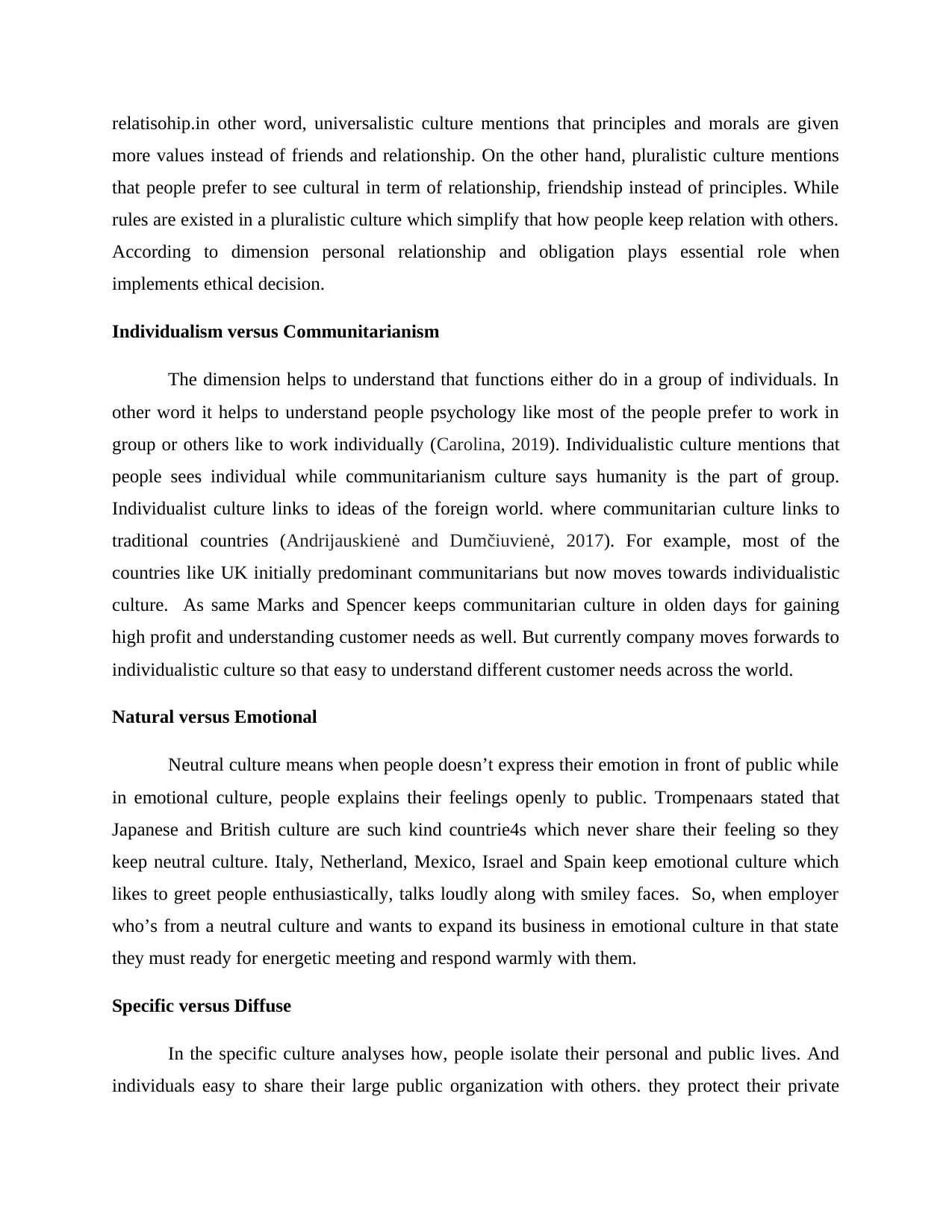
relatisohip.in other word, universalistic culture mentions that principles and morals are given
more values instead of friends and relationship. On the other hand, pluralistic culture mentions
that people prefer to see cultural in term of relationship, friendship instead of principles. While
rules are existed in a pluralistic culture which simplify that how people keep relation with others.
According to dimension personal relationship and obligation plays essential role when
implements ethical decision.
Individualism versus Communitarianism
The dimension helps to understand that functions either do in a group of individuals. In
other word it helps to understand people psychology like most of the people prefer to work in
group or others like to work individually (Carolina, 2019). Individualistic culture mentions that
people sees individual while communitarianism culture says humanity is the part of group.
Individualist culture links to ideas of the foreign world. where communitarian culture links to
traditional countries (Andrijauskienė and Dumčiuvienė, 2017). For example, most of the
countries like UK initially predominant communitarians but now moves towards individualistic
culture. As same Marks and Spencer keeps communitarian culture in olden days for gaining
high profit and understanding customer needs as well. But currently company moves forwards to
individualistic culture so that easy to understand different customer needs across the world.
Natural versus Emotional
Neutral culture means when people doesn’t express their emotion in front of public while
in emotional culture, people explains their feelings openly to public. Trompenaars stated that
Japanese and British culture are such kind countrie4s which never share their feeling so they
keep neutral culture. Italy, Netherland, Mexico, Israel and Spain keep emotional culture which
likes to greet people enthusiastically, talks loudly along with smiley faces. So, when employer
who’s from a neutral culture and wants to expand its business in emotional culture in that state
they must ready for energetic meeting and respond warmly with them.
Specific versus Diffuse
In the specific culture analyses how, people isolate their personal and public lives. And
individuals easy to share their large public organization with others. they protect their private
more values instead of friends and relationship. On the other hand, pluralistic culture mentions
that people prefer to see cultural in term of relationship, friendship instead of principles. While
rules are existed in a pluralistic culture which simplify that how people keep relation with others.
According to dimension personal relationship and obligation plays essential role when
implements ethical decision.
Individualism versus Communitarianism
The dimension helps to understand that functions either do in a group of individuals. In
other word it helps to understand people psychology like most of the people prefer to work in
group or others like to work individually (Carolina, 2019). Individualistic culture mentions that
people sees individual while communitarianism culture says humanity is the part of group.
Individualist culture links to ideas of the foreign world. where communitarian culture links to
traditional countries (Andrijauskienė and Dumčiuvienė, 2017). For example, most of the
countries like UK initially predominant communitarians but now moves towards individualistic
culture. As same Marks and Spencer keeps communitarian culture in olden days for gaining
high profit and understanding customer needs as well. But currently company moves forwards to
individualistic culture so that easy to understand different customer needs across the world.
Natural versus Emotional
Neutral culture means when people doesn’t express their emotion in front of public while
in emotional culture, people explains their feelings openly to public. Trompenaars stated that
Japanese and British culture are such kind countrie4s which never share their feeling so they
keep neutral culture. Italy, Netherland, Mexico, Israel and Spain keep emotional culture which
likes to greet people enthusiastically, talks loudly along with smiley faces. So, when employer
who’s from a neutral culture and wants to expand its business in emotional culture in that state
they must ready for energetic meeting and respond warmly with them.
Specific versus Diffuse
In the specific culture analyses how, people isolate their personal and public lives. And
individuals easy to share their large public organization with others. they protect their private
Paraphrase This Document
Need a fresh take? Get an instant paraphrase of this document with our AI Paraphraser
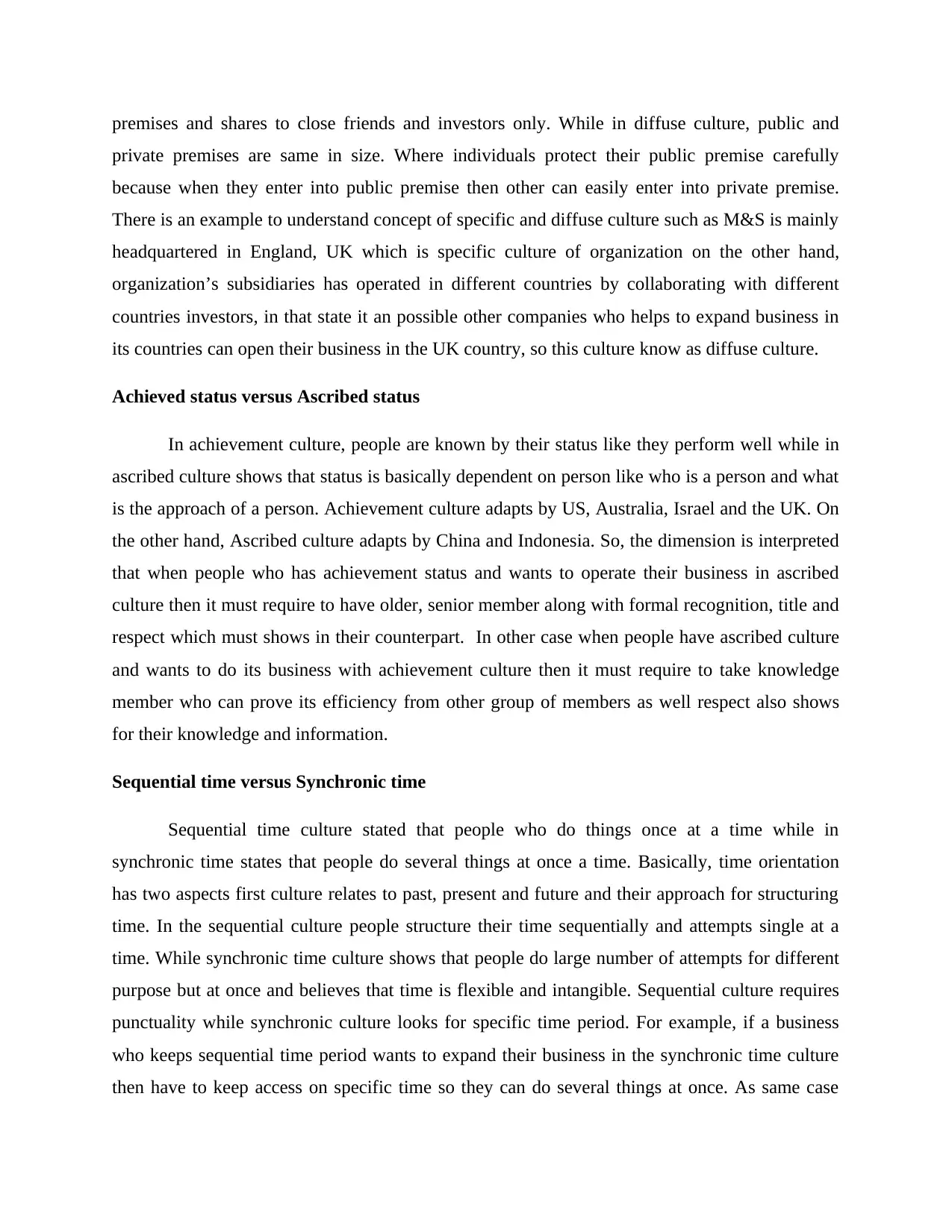
premises and shares to close friends and investors only. While in diffuse culture, public and
private premises are same in size. Where individuals protect their public premise carefully
because when they enter into public premise then other can easily enter into private premise.
There is an example to understand concept of specific and diffuse culture such as M&S is mainly
headquartered in England, UK which is specific culture of organization on the other hand,
organization’s subsidiaries has operated in different countries by collaborating with different
countries investors, in that state it an possible other companies who helps to expand business in
its countries can open their business in the UK country, so this culture know as diffuse culture.
Achieved status versus Ascribed status
In achievement culture, people are known by their status like they perform well while in
ascribed culture shows that status is basically dependent on person like who is a person and what
is the approach of a person. Achievement culture adapts by US, Australia, Israel and the UK. On
the other hand, Ascribed culture adapts by China and Indonesia. So, the dimension is interpreted
that when people who has achievement status and wants to operate their business in ascribed
culture then it must require to have older, senior member along with formal recognition, title and
respect which must shows in their counterpart. In other case when people have ascribed culture
and wants to do its business with achievement culture then it must require to take knowledge
member who can prove its efficiency from other group of members as well respect also shows
for their knowledge and information.
Sequential time versus Synchronic time
Sequential time culture stated that people who do things once at a time while in
synchronic time states that people do several things at once a time. Basically, time orientation
has two aspects first culture relates to past, present and future and their approach for structuring
time. In the sequential culture people structure their time sequentially and attempts single at a
time. While synchronic time culture shows that people do large number of attempts for different
purpose but at once and believes that time is flexible and intangible. Sequential culture requires
punctuality while synchronic culture looks for specific time period. For example, if a business
who keeps sequential time period wants to expand their business in the synchronic time culture
then have to keep access on specific time so they can do several things at once. As same case
private premises are same in size. Where individuals protect their public premise carefully
because when they enter into public premise then other can easily enter into private premise.
There is an example to understand concept of specific and diffuse culture such as M&S is mainly
headquartered in England, UK which is specific culture of organization on the other hand,
organization’s subsidiaries has operated in different countries by collaborating with different
countries investors, in that state it an possible other companies who helps to expand business in
its countries can open their business in the UK country, so this culture know as diffuse culture.
Achieved status versus Ascribed status
In achievement culture, people are known by their status like they perform well while in
ascribed culture shows that status is basically dependent on person like who is a person and what
is the approach of a person. Achievement culture adapts by US, Australia, Israel and the UK. On
the other hand, Ascribed culture adapts by China and Indonesia. So, the dimension is interpreted
that when people who has achievement status and wants to operate their business in ascribed
culture then it must require to have older, senior member along with formal recognition, title and
respect which must shows in their counterpart. In other case when people have ascribed culture
and wants to do its business with achievement culture then it must require to take knowledge
member who can prove its efficiency from other group of members as well respect also shows
for their knowledge and information.
Sequential time versus Synchronic time
Sequential time culture stated that people who do things once at a time while in
synchronic time states that people do several things at once a time. Basically, time orientation
has two aspects first culture relates to past, present and future and their approach for structuring
time. In the sequential culture people structure their time sequentially and attempts single at a
time. While synchronic time culture shows that people do large number of attempts for different
purpose but at once and believes that time is flexible and intangible. Sequential culture requires
punctuality while synchronic culture looks for specific time period. For example, if a business
who keeps sequential time period wants to expand their business in the synchronic time culture
then have to keep access on specific time so they can do several things at once. As same case

with synchronic time period when a business has this culture and expands its business with other
sequential culture then must have different innovative idea which they can apply at time to take
their position.
Internal versus External control
According to internal control culture, people believes to control on outcomes which they
received and keeps dominative attitudes towards environment. On the other hand, outer control
culture states that people believe to adapts different culture for comply with external
environment and keeps more flexible attitudes (Meng, Yan and Xue, 2018). When a business has
internal directed culture and wants to expand its business in external directed culture then it is
must require to keep flexibility in policies and products as well so that can establish their
business according to others. in other case when employer who has external directed culture and
wants to initiate in the internal directed culture then it requires that business should have
dominant attitude towards environment and has access on the perceived outcomes.
Hall Theory
Hall culture theory has developed by American anthropologist and researcher of cross
culture named Edward Twitchell Hall, Jr. In this theory, Hall mainly has talked about
intercultural communication. Some major topics which has involved in hall theory has been
discussed below;
Intercultural Communication Competence
Intercultural communication competence is too necessary for M&S to easily run their
business operations in the international market. This competence gives opportunity to company
for understanding existing culture of place where it is running its operations. This company has
different stores in different countries, but these stores are completely regulated by head office of
the company which has located to in the United Kingdom. When top-level management of
company want to communicate with their employees who works in different countries, in this
situation management uses intercultural communication competence.
Skills
sequential culture then must have different innovative idea which they can apply at time to take
their position.
Internal versus External control
According to internal control culture, people believes to control on outcomes which they
received and keeps dominative attitudes towards environment. On the other hand, outer control
culture states that people believe to adapts different culture for comply with external
environment and keeps more flexible attitudes (Meng, Yan and Xue, 2018). When a business has
internal directed culture and wants to expand its business in external directed culture then it is
must require to keep flexibility in policies and products as well so that can establish their
business according to others. in other case when employer who has external directed culture and
wants to initiate in the internal directed culture then it requires that business should have
dominant attitude towards environment and has access on the perceived outcomes.
Hall Theory
Hall culture theory has developed by American anthropologist and researcher of cross
culture named Edward Twitchell Hall, Jr. In this theory, Hall mainly has talked about
intercultural communication. Some major topics which has involved in hall theory has been
discussed below;
Intercultural Communication Competence
Intercultural communication competence is too necessary for M&S to easily run their
business operations in the international market. This competence gives opportunity to company
for understanding existing culture of place where it is running its operations. This company has
different stores in different countries, but these stores are completely regulated by head office of
the company which has located to in the United Kingdom. When top-level management of
company want to communicate with their employees who works in different countries, in this
situation management uses intercultural communication competence.
Skills
⊘ This is a preview!⊘
Do you want full access?
Subscribe today to unlock all pages.

Trusted by 1+ million students worldwide
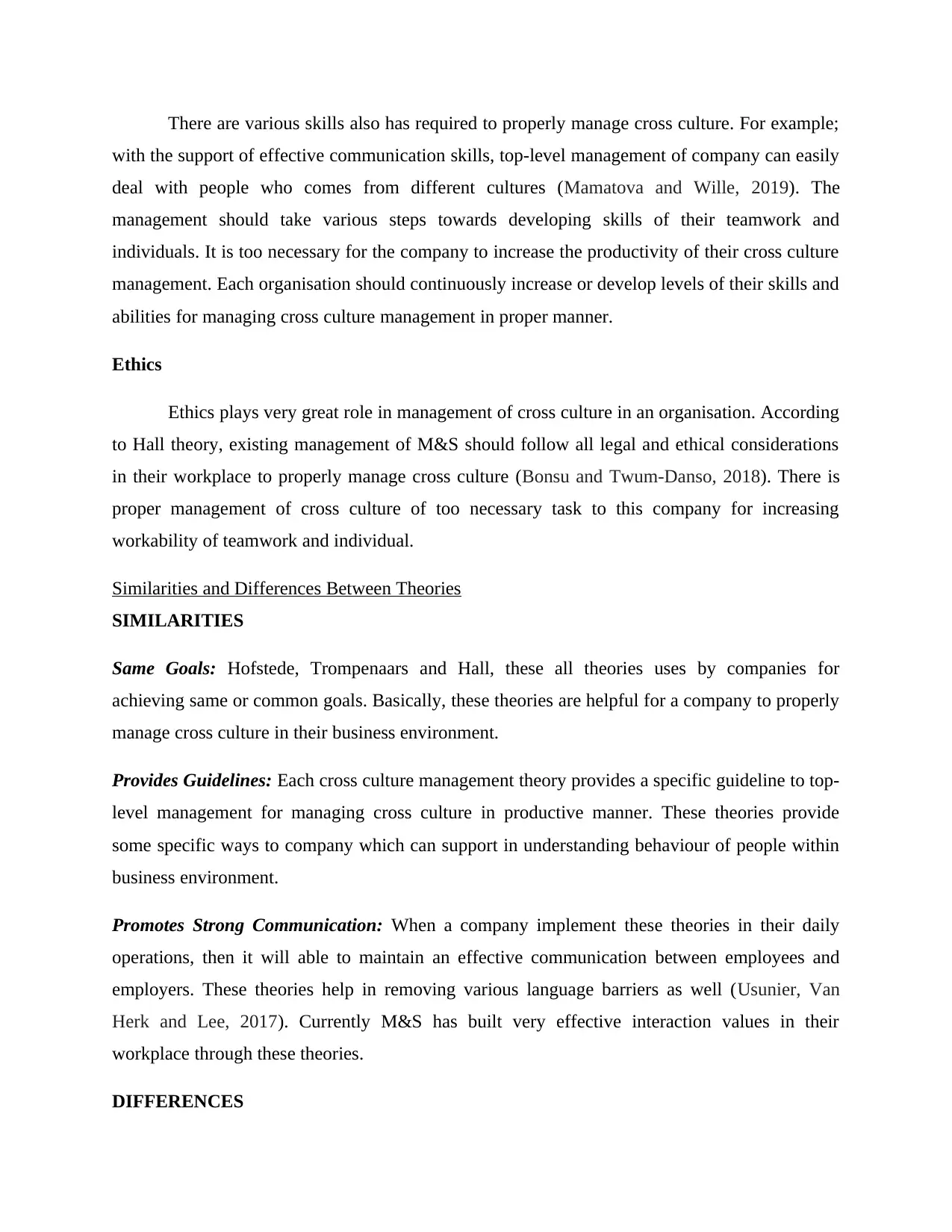
There are various skills also has required to properly manage cross culture. For example;
with the support of effective communication skills, top-level management of company can easily
deal with people who comes from different cultures (Mamatova and Wille, 2019). The
management should take various steps towards developing skills of their teamwork and
individuals. It is too necessary for the company to increase the productivity of their cross culture
management. Each organisation should continuously increase or develop levels of their skills and
abilities for managing cross culture management in proper manner.
Ethics
Ethics plays very great role in management of cross culture in an organisation. According
to Hall theory, existing management of M&S should follow all legal and ethical considerations
in their workplace to properly manage cross culture (Bonsu and Twum-Danso, 2018). There is
proper management of cross culture of too necessary task to this company for increasing
workability of teamwork and individual.
Similarities and Differences Between Theories
SIMILARITIES
Same Goals: Hofstede, Trompenaars and Hall, these all theories uses by companies for
achieving same or common goals. Basically, these theories are helpful for a company to properly
manage cross culture in their business environment.
Provides Guidelines: Each cross culture management theory provides a specific guideline to top-
level management for managing cross culture in productive manner. These theories provide
some specific ways to company which can support in understanding behaviour of people within
business environment.
Promotes Strong Communication: When a company implement these theories in their daily
operations, then it will able to maintain an effective communication between employees and
employers. These theories help in removing various language barriers as well (Usunier, Van
Herk and Lee, 2017). Currently M&S has built very effective interaction values in their
workplace through these theories.
DIFFERENCES
with the support of effective communication skills, top-level management of company can easily
deal with people who comes from different cultures (Mamatova and Wille, 2019). The
management should take various steps towards developing skills of their teamwork and
individuals. It is too necessary for the company to increase the productivity of their cross culture
management. Each organisation should continuously increase or develop levels of their skills and
abilities for managing cross culture management in proper manner.
Ethics
Ethics plays very great role in management of cross culture in an organisation. According
to Hall theory, existing management of M&S should follow all legal and ethical considerations
in their workplace to properly manage cross culture (Bonsu and Twum-Danso, 2018). There is
proper management of cross culture of too necessary task to this company for increasing
workability of teamwork and individual.
Similarities and Differences Between Theories
SIMILARITIES
Same Goals: Hofstede, Trompenaars and Hall, these all theories uses by companies for
achieving same or common goals. Basically, these theories are helpful for a company to properly
manage cross culture in their business environment.
Provides Guidelines: Each cross culture management theory provides a specific guideline to top-
level management for managing cross culture in productive manner. These theories provide
some specific ways to company which can support in understanding behaviour of people within
business environment.
Promotes Strong Communication: When a company implement these theories in their daily
operations, then it will able to maintain an effective communication between employees and
employers. These theories help in removing various language barriers as well (Usunier, Van
Herk and Lee, 2017). Currently M&S has built very effective interaction values in their
workplace through these theories.
DIFFERENCES
Paraphrase This Document
Need a fresh take? Get an instant paraphrase of this document with our AI Paraphraser
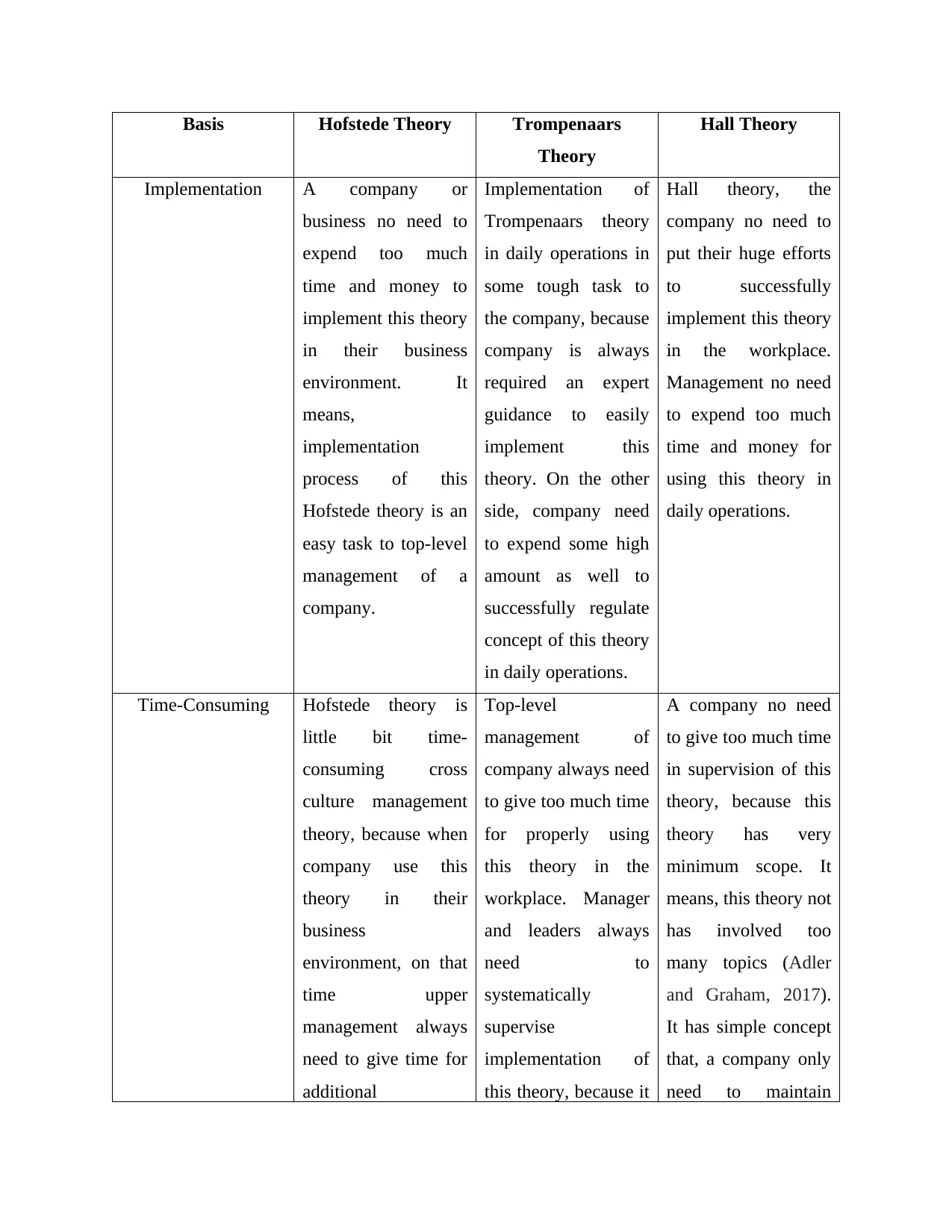
Basis Hofstede Theory Trompenaars
Theory
Hall Theory
Implementation A company or
business no need to
expend too much
time and money to
implement this theory
in their business
environment. It
means,
implementation
process of this
Hofstede theory is an
easy task to top-level
management of a
company.
Implementation of
Trompenaars theory
in daily operations in
some tough task to
the company, because
company is always
required an expert
guidance to easily
implement this
theory. On the other
side, company need
to expend some high
amount as well to
successfully regulate
concept of this theory
in daily operations.
Hall theory, the
company no need to
put their huge efforts
to successfully
implement this theory
in the workplace.
Management no need
to expend too much
time and money for
using this theory in
daily operations.
Time-Consuming Hofstede theory is
little bit time-
consuming cross
culture management
theory, because when
company use this
theory in their
business
environment, on that
time upper
management always
need to give time for
additional
Top-level
management of
company always need
to give too much time
for properly using
this theory in the
workplace. Manager
and leaders always
need to
systematically
supervise
implementation of
this theory, because it
A company no need
to give too much time
in supervision of this
theory, because this
theory has very
minimum scope. It
means, this theory not
has involved too
many topics (Adler
and Graham, 2017).
It has simple concept
that, a company only
need to maintain
Theory
Hall Theory
Implementation A company or
business no need to
expend too much
time and money to
implement this theory
in their business
environment. It
means,
implementation
process of this
Hofstede theory is an
easy task to top-level
management of a
company.
Implementation of
Trompenaars theory
in daily operations in
some tough task to
the company, because
company is always
required an expert
guidance to easily
implement this
theory. On the other
side, company need
to expend some high
amount as well to
successfully regulate
concept of this theory
in daily operations.
Hall theory, the
company no need to
put their huge efforts
to successfully
implement this theory
in the workplace.
Management no need
to expend too much
time and money for
using this theory in
daily operations.
Time-Consuming Hofstede theory is
little bit time-
consuming cross
culture management
theory, because when
company use this
theory in their
business
environment, on that
time upper
management always
need to give time for
additional
Top-level
management of
company always need
to give too much time
for properly using
this theory in the
workplace. Manager
and leaders always
need to
systematically
supervise
implementation of
this theory, because it
A company no need
to give too much time
in supervision of this
theory, because this
theory has very
minimum scope. It
means, this theory not
has involved too
many topics (Adler
and Graham, 2017).
It has simple concept
that, a company only
need to maintain
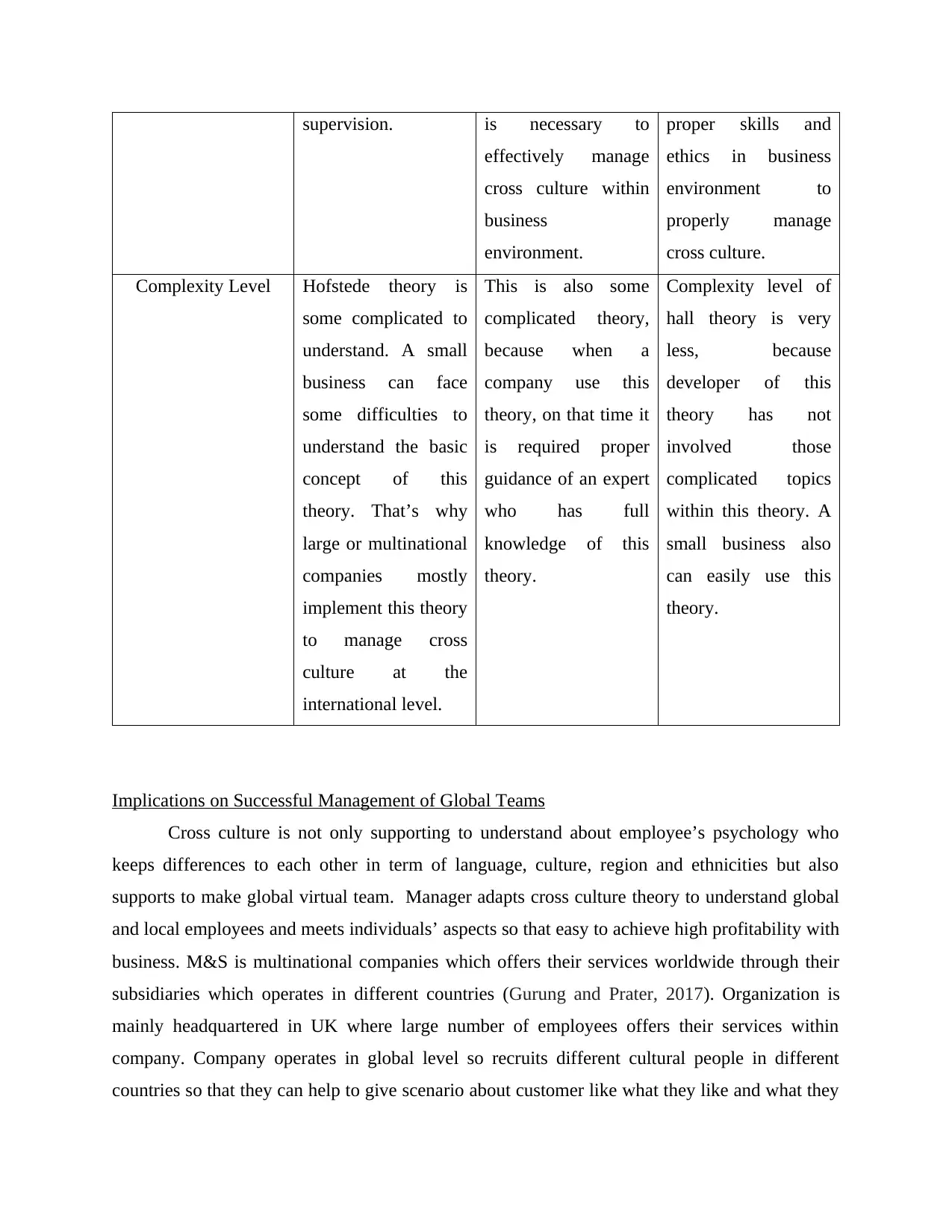
supervision. is necessary to
effectively manage
cross culture within
business
environment.
proper skills and
ethics in business
environment to
properly manage
cross culture.
Complexity Level Hofstede theory is
some complicated to
understand. A small
business can face
some difficulties to
understand the basic
concept of this
theory. That’s why
large or multinational
companies mostly
implement this theory
to manage cross
culture at the
international level.
This is also some
complicated theory,
because when a
company use this
theory, on that time it
is required proper
guidance of an expert
who has full
knowledge of this
theory.
Complexity level of
hall theory is very
less, because
developer of this
theory has not
involved those
complicated topics
within this theory. A
small business also
can easily use this
theory.
Implications on Successful Management of Global Teams
Cross culture is not only supporting to understand about employee’s psychology who
keeps differences to each other in term of language, culture, region and ethnicities but also
supports to make global virtual team. Manager adapts cross culture theory to understand global
and local employees and meets individuals’ aspects so that easy to achieve high profitability with
business. M&S is multinational companies which offers their services worldwide through their
subsidiaries which operates in different countries (Gurung and Prater, 2017). Organization is
mainly headquartered in UK where large number of employees offers their services within
company. Company operates in global level so recruits different cultural people in different
countries so that they can help to give scenario about customer like what they like and what they
effectively manage
cross culture within
business
environment.
proper skills and
ethics in business
environment to
properly manage
cross culture.
Complexity Level Hofstede theory is
some complicated to
understand. A small
business can face
some difficulties to
understand the basic
concept of this
theory. That’s why
large or multinational
companies mostly
implement this theory
to manage cross
culture at the
international level.
This is also some
complicated theory,
because when a
company use this
theory, on that time it
is required proper
guidance of an expert
who has full
knowledge of this
theory.
Complexity level of
hall theory is very
less, because
developer of this
theory has not
involved those
complicated topics
within this theory. A
small business also
can easily use this
theory.
Implications on Successful Management of Global Teams
Cross culture is not only supporting to understand about employee’s psychology who
keeps differences to each other in term of language, culture, region and ethnicities but also
supports to make global virtual team. Manager adapts cross culture theory to understand global
and local employees and meets individuals’ aspects so that easy to achieve high profitability with
business. M&S is multinational companies which offers their services worldwide through their
subsidiaries which operates in different countries (Gurung and Prater, 2017). Organization is
mainly headquartered in UK where large number of employees offers their services within
company. Company operates in global level so recruits different cultural people in different
countries so that they can help to give scenario about customer like what they like and what they
⊘ This is a preview!⊘
Do you want full access?
Subscribe today to unlock all pages.

Trusted by 1+ million students worldwide
1 out of 17
Related Documents
Your All-in-One AI-Powered Toolkit for Academic Success.
+13062052269
info@desklib.com
Available 24*7 on WhatsApp / Email
![[object Object]](/_next/static/media/star-bottom.7253800d.svg)
Unlock your academic potential
Copyright © 2020–2025 A2Z Services. All Rights Reserved. Developed and managed by ZUCOL.




